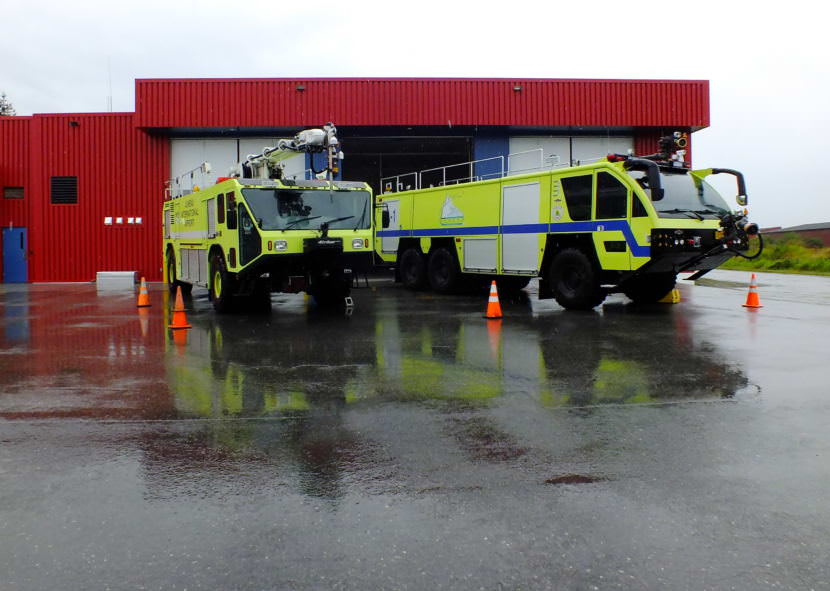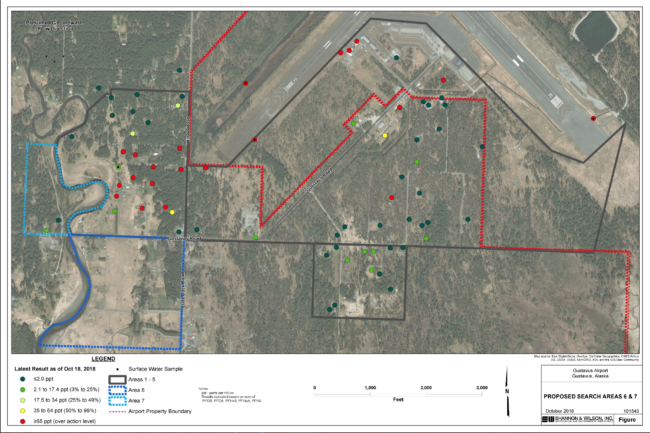
Burning fuel from a fiery plane crash can be tough to put out. That’s why firefighters at Alaska’s airports carry chemical agents for the job, and for decades the industry standard has been aqueous film-forming foams — known as AFFF — that smother the blaze.
“The whole goal of the foam is to essentially encapsulate the fuel that prevent oxygen from getting to it,” said John Binder, a deputy commissioner of Alaska’s Department of Transportation and Public Facilities overseeing state-owned airports.
But the same chemicals that make it effective for fighting fire are also linked to contamination in drinking water.
“It contains the (per- and polyfluoroalkyl substances, or PFAS) family of chemicals, and they have been used liberally in Gustavus and are in a lot of our groundwater,” said Kelly McLaughlin. She lives in the small Southeast community. State regulators said her household’s well is unsafe to drink from, so she’s been receiving state-supplied bottled water for more than a year.
Now she heads the grassroots Gustavus PFAS Action Coalition that has been asking for foams to be removed from her local airport.
“I just, I feel like it’s so toxic. It just needs to be gone,” she said.
But state officials said they’re not ready to do that, despite requests from Gustavus’ elected officials.
Gustavus Mayor Calvin Casipit said he understands where the state’s coming from, but Gustavus is in a unique situation — it is a low-lying area with a cluster of private wells around its airport.

“I know they’ve used AFFF you know at other airports and stuff but do people drink the groundwater there?” Casipit said.
There are federal requirements for the types of firefighting agents kept at airports, but AFFF isn’t required at smaller ones — like Gustavus’s.
“The (Federal Aviation Administration) has an alternative that that meets the regulations. The community here doesn’t want to have this stuff around. I think that should be honored,” Casipit said.
But those in the know said the alternative just doesn’t work as well.
Juneau’s fire chief Rich Etheridge said he understands the environmental concerns, but when it comes to putting out burning aircraft, “there isn’t a product on the market that’s totally environmentally friendly that works like it’s supposed to.”
There’s contamination in Juneau too. Those PFAS chemicals linked to the firefighting foam have been measured in groundwater around the fire department’s training facility. The results of additional testing in the wetlands around Juneau’s airport are pending.
In the meantime, PFAS contamination from firefighting foams have officially tainted the drinking water in five communities. Because of the link to the foam, DOT is the legally responsible party and has been paying for bottled water supplied to households around Bristol Bay, Fairbanks, Yakutat and Gustavus.
DOT Deputy Commissioner John Binder said his agency is trying to balance the risk of contamination with its responsibility to keep airports safe. He said Alaska firefighters no longer train with the foam.
“The state and the various departments — primarily DOT and (the Alaska Department of Environmental Conservation) as well — are certainly well aware of the challenges associated with this subject. We’re working closely with the FAA on alternatives out there and doing our best to ensure that no contamination happens unintentionally here in the meantime, while we wait for a non-fluorinated foam to come available,” Binder said.
Meanwhile, the Pentagon is investing millions in research for alternatives. And last year, Washington became the first state in the nation to begin phasing out PFAS-laced firefighting foam.
Clarification: This article has been updated to clarify that while FAA regulations don’t require AFFF-type firefighting foam to be stored at small commercial airports like in Gustavus, it still requires it for larger facilities.
